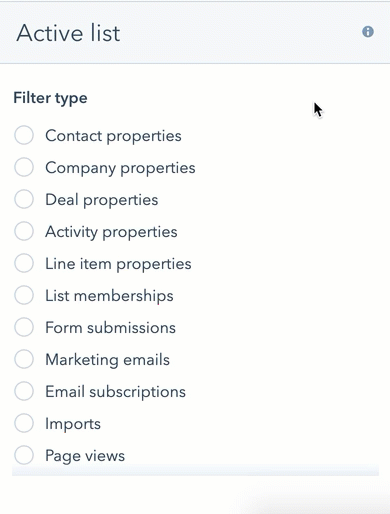I love The Great British Bake Off. It’s a simply amazing show that never ceases to relax and excite me no matter what type of day I’ve had. So naturally, when preparing to write this blog, I took some time to clear my head and learn a little about making a tart. That’s when I realized baking is a lot like list segmentation.
What? No, Chris. You’re crazy. Segmenting your contacts has nothing to do with creating the perfect tart. Au contraire! When you set out to bake a complicated dish, you have tons of different ingredients that all need to go toward one final dessert. But you can’t just dump them all in a bowl and hope it works. You have to separate the wet ingredients in one area, the dry ingredients in another, melt butter in this pan, combine sugar in that pot. Only when each ingredient can perform its specific task will you accomplish a great British bake.
List segmentation is like separating ingredients in your contacts list. It takes something potentially overwhelming like a jumbled spreadsheet of contacts and orders them into neat rows based on their similarities. By doing so, you can easily choose which groups you need to address now, which can wait til later, and what goal you have for each. When you market to specific lists, you allow yourself to accomplish specific goals with each group that eventually become an overall success for your brand.
What Is List Segmentation?
Segmentation is part of an overall digital marketing strategy. It’s all about organizing your list of contacts so you can better personalize your marketing, improve your sales process and keep your data clean and updated. You could do this by buyer personas, geographic location, demographics, customer journey stage, behavioral data — if you can name it, you can segment it.
Many people use segmented lists in their email marketing so they can send targeted emails to small pockets of their client base. This often helps to boost open rates and click-through rates because you’re delivering email content that’s highly relevant to their needs.
A segmentation strategy comes in handy particularly for businesses who’ve been building their contact database lists for a long time. You might have endless spreadsheets of data about your target audience and customers that your CRM pulls from when you start a new email marketing campaign, look for cold leads or try to identify a specific group of contacts.
This is great if you want one giant repository of information, but not as helpful when you're trying to implement effective email marketing strategies that help your business grow.
For example, let’s say you’d like to reach out to clients who haven’t made a purchase in over a year. If your business is small enough you might remember a handful (but not all) of these names. If you’re larger, then you’d have to find a way to sift through your spreadsheets, which might take hours.
With a tool like the HubSpot CRM, you can use behavioral segmentation to pull out contacts who meet the purchase history criteria and send them a re-engagement email or enroll them in a re-engagement series. This boosts your chances of conversion because you’re not sending generic email offers or updates; you’re speaking directly to that contact and their situation, which grabs their attention.
Why Segment?
You might have pieced this together by now because subtlety is not my strong suit. In short, list segmentation helps you better target contact groups.
If you know that Sally, Susan and Sam all like cherry pie, then you can send them your secret recipe and they’ll thank you for it. Meanwhile, you can exclude Jen, Judy and John who all loathe cherry pie and would be offended to even see the word in a subject line.
When you create lists based on specific contact properties — demographic data, job title, new subscribers, etc. — you can speak directly to the needs of those customers. You can send them relevant, valuable content that speaks to their needs and where they are in their customer journey. Plus, if you’re effectively targeting your information, you’ll improve the deliverability of your emails. They won’t get lost in a sea of irrelevant messages also coming from your brand, which can help keep you from being marked as spam.
Now that you get the gist, let’s look at some specific examples of how list segmentation can make your daily processes easier. Let’s use an email marketing campaign as an example.
Personalize Content and the Customer Experience
Marketing technology has advanced far beyond personalizing emails with a simple “Hey [First name]!” With email marketing segmentation, you can focus your efforts on specific wants and needs of individual customers.

You can create groups of people who share similar characteristics — a.k.a. demographic segmentation. For example, you might have 10 contact records that show over 100 page views of your blog about building a website. But none of them have signed up for your web builder services.
Send them an email with a clear CTA, a link to a landing page or a signup form to a webinar that might help nudge them in the right direction. If five of them engage with the link, make a new list and keep sending relevant content to where they are in the marketing funnel. You see how this works?
Speaking directly to what your customer needs is the best way to forge a connection and get them on board with your brand. Segmenting all your email subscribers into quickly identifiable groups makes this task easy.
Qualify Leads and Focus on the Right Deals
Have you ever started asking someone in a store lots of questions about a product you were considering, only to find out five minutes later that person did not in fact work there? Yeah…me either…
Trying to sell to people who aren’t interested can feel kind of like that. It doesn't matter how many cart abandonment emails you send, they just ain't buying.
You might spend lots of time and energy on a single lead only for them to ghost you a few weeks later. Wouldn’t it be nice if there was a marketing tool to help you qualify leads and see which contacts were most likely to close a deal? *magic bell sounds* There is!
Lead segmentation (same as email list segmentation but for leads) can filter through all of your contact records to find the ones that match your specific list criteria. For example, you might want to find people who have bought from your company in the last year and spent over $100 in one purchase.
By choosing specific parameters, you can measure leads’ level of interest and focus your energy on those most likely to convert. You can send different emails to different leads based on where they are in their journey and use automation to do it without costing you hours of your day.
TL;DR: It saves time and energy and puts you in a better position to make sales.
View Clean and Accurate Data
This is perhaps the most helpful when you have a backlog of records in your contact database. Odds are you haven’t updated their information in a while. You might have handfuls of people who have unsubscribed or have moved onto a different lifecycle stage and should be put in a new workflow. Your marketing automation only works if the messaging is relevant to your users, so you need to keep up with where they are in relation to your brand.
In addition to finding inactive contacts and people who are in the wrong marketing bucket, list segmentation can help you view metrics about your inbound marketing efforts overall. You can see who joined your list through a form submission, who is regularly clicking through to your website or who has had the longest running list membership.
The filters in segmentation give you plenty of opportunities to find precise information about your contacts and see how that fits into the whole picture of your business. It also breaks up your database into more manageable chunks that you can easily digest and analyze, which means you can make more informed strategic decisions.
For more on cleaning up your HubSpot portal, check out this video 👇
Access Advanced Reporting and Know Where to Invest
You might have spent a good chunk of your budget on lead nurturing through various channels. Wouldn’t it be nice to know which of those efforts were actually producing results?
With list segmentation, you can create a kind of pseudo-reporting analytic by calling up all the people who acted through a specific platform. Maybe you want to see who joined your email list from a social media ad or who found a product page through a link in your marketing emails. You can apply those filters to your entire contact database to call up just the people who fit the bill.
These metrics can inform where you decide to invest your marketing dollars. For convenience sake we'll use those two examples I just mentioned. Let’s say you pull up the social media list and see 90% of your list has engaged with the ad. Inversely, only about 10% are engaging with your emails. Now you know social media is where you have the best chance of reaching people.
Types of Segmentation
Static Lists
There are two types of lists when it comes to segmenting: static lists and active lists. First, let’s look at the former.
Contacts in static lists are like the players in freeze tag who have already been tagged. They’re not moving, not changing, not actively influencing the game in any way. They’re still players, mind you, just having less fun than everyone else.
In reality, this list might look like customers aged 25-40 who bought a house on Long Island in November 2021. You’ll end up with a finite number of results, which can be helpful if you need to see a specific user group in a snapshot of time.
But how does this help with marketing? I’m glad you asked. In our freeze tag game, you’re “it.” And it’s easier to tell if you’re winning when you can count how many people are frozen. Static lists show you groups that share a specific quality, within a specific moment in time, which means you can more effectively (and consistently) target their needs because they’re always right where you left them.
Active Lists
Active lists represent all those players in freeze tag who are still running around the playground. Their position can change and they have the most influence on the game. That’s why these lists change frequently and are modified when you gain new customers.
Because these lists are always on the move, you want to make sure they’re consistently being updated. That’s where your trusty robot companion joins the game. (Okay, maybe this metaphor is getting out of hand.) What I mean is, automation can help you keep all of your lists up to date by ensuring those contacts that meet the requirements are included and those that don’t (or no longer do) are removed.
With automation, your CRM can filter new contacts for criteria that match existing active lists and add them in…well automatically. You can set it up to trigger a specific nurture series based on their interests or make bulk edits to a single list if you need to add or remove filter criteria. This saves you and your team tons of time and energy that can be better spent on other areas of your business.
How do you segment?
I promised HubSpot specifics, and now I’m ready to deliver. HubSpot list segmentation is part of the HubSpot CRM, which is free to everyone! That means you don’t have to purchase a specific Hub to use the feature. To employ automated workflows and send emails to your lists, however, you will need access to the Marketing Hub.
Creating a list
To make a HubSpot list, you’ll want to go to the “Contacts” tab at the top of the page in your HubSpot account. In the dropdown menu, click “List,” then select the orange button on the right side of the screen that says “Create List.”
This will take you to where you can name your list, choose where to pull information from (contacts or company) and start adding filters.
Navigating filters
After you name your list and choose its type, you’ll have the option to choose from a number of different filter types. Within each filter, there’s a list of different property values that help you further refine your parameters.
For example, you can filter through your contact lists for people who submitted a form on your website. Once you select that, you’ll be able to add extra filters with “and/or” commands if there’s more than one requirement you need in the filter.
Each filter group gives you plenty of options for specific properties, so you can create lists with as many or as few parameters as you’d like.
Custom Properties
If you’re scrolling through the list of filters and don’t see what you’re looking for, have no fear. It’s not the end of the line. HubSpot knows it can’t predict literally all of your needs, so it included a way to create custom properties.
Go to your settings at the top right of the page, then scroll down to properties on the left side bar. That will open the page where you can search or make new properties. Under the “contact properties” tab, you just click the “create a property” button. That opens a side bar where you can select all the specifics of your new property.
This can be incredibly helpful if you’re looking for specific information outside of HubSpot itself, such as leads that came from external channels.
Mistakes to avoid
As with anything, there are some mistakes that can make list segmentation seem like a pain. But I want you to be just as excited about organizing your contacts as I am, so hopefully I can help you avoid those pitfalls. Here’s what you need to look out for:
- Make sure your list is the type you need. Accidentally creating a “static list” when you need it to be “active” can really throw a wrench in your data. Always double check your selection before you finish creating your lists.
- Use the “and/or” filters correctly. They can get a little confusing when you have multiple properties tacked on to a single filter. Just remember that using “and” adds the new criteria to your list, while “or” provides a different set of criteria that isn’t connected to those above it.
- Be careful when using lists to make a single change. If you leave unused lists or lists with irrelevant filters in your CRM, then it might create a new kind of clutter—lists you aren’t using. Try to stick with lists that match your needs and delete ones you aren’t using anymore.
List segmentation is an important part of any successful sales or marketing effort. It keeps your contacts organized and your information categorized so you can easily see what your next step should be. Lists make it easy to achieve your business goals and monitor your marketing.
That being said, we know it can also be an overwhelming task to take on alone. If you feel like you need some help or just want a little more guidance, reach out to us! We’d love to help you get organized and boost the effectiveness of your marketing campaigns.

